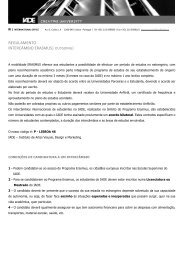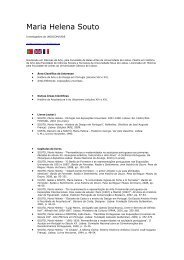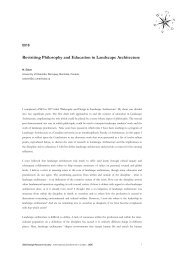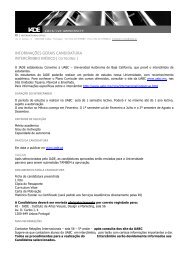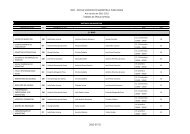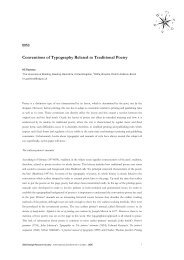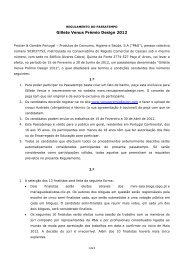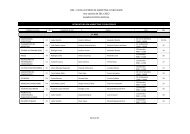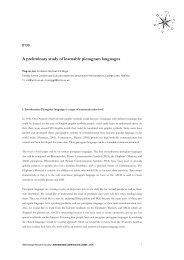“ETHICS? DESIGN?” BY CLIVE DILNOT IN STANLEY ... - IADE
“ETHICS? DESIGN?” BY CLIVE DILNOT IN STANLEY ... - IADE
“ETHICS? DESIGN?” BY CLIVE DILNOT IN STANLEY ... - IADE
You also want an ePaper? Increase the reach of your titles
YUMPU automatically turns print PDFs into web optimized ePapers that Google loves.
<strong>“ETHICS</strong>? <strong>DESIGN</strong>?<strong>”</strong> <strong>BY</strong> <strong>CLIVE</strong> <strong>DILNOT</strong> <strong>IN</strong> <strong>STANLEY</strong> TIGERMAN (ED) THE ARCHEWORKS PAPERS,<br />
VOLUME 1, NUMBER TWO (CHICAGO: ARCHEWORKS, 2005)::<br />
BOOK REVIEW <strong>BY</strong> EDUARDO CÔRTE-REAL<br />
ISBN 0-9753405-1-4<br />
Available for purchase at: http://www.archeworks.org/publications.cfm<br />
“Ethics? Design?<strong>”</strong> is a 46, 000 word text resulting from a lecture by Clive Dilnot to the audience in<br />
Archeworks a School founded by Eva Maddox and Stanley Tigerman in Chicago. The author explains in an<br />
introductory note that he decided to preserve the lecture format because of pedagogical reasons. So the<br />
reader may expect to sometimes hear the lecturer. However, those not familiarized with the School of<br />
Frankfurt style mastered by Theodor Adorno, for instance, may expect some difficulties in reading it.<br />
Only during the twentieth century the concept of “Design<strong>”</strong> gained its full global meaning, a century in which<br />
the human actions especially challenged the millenary notions of Ethics.<br />
Clive Dilnot faces this demanding coincidence: When Design as a concept inflated up to the dimension of<br />
encompassing all of the artificial production, no longer being innocent in the existential drama, a century of<br />
unexpected methodic destruction and suffering occurs. Therefore, a reasonable number of thinkers about<br />
Ethics have something to say, or to be read, about design. On the other hand the particular audience of<br />
Archeworks is related with architecture by disciplinary institution linked to Ethics.<br />
One must not expect in Dilnot’s text a simple engineered structure of arguments; the text has a complex<br />
musical structure, almost symphonic even though if only with two greater movements: The first digresses<br />
through the Ethical thinking of the past century ending with some chords, through the notion of Heterotopia<br />
that annunciate the second part, propositional in its structure. It can also be described as the confection of<br />
the mille-feuilles gateaux with arguments being folded and pressed, folded and pressed on and on.<br />
The grand themes come from Giorgio Agamben and Herbert Simon in a permanent confrontation of content<br />
and form respectively. Agamben last exhortation about art becoming the artness of Design, in Dilnot’s<br />
argument, is consecutively constructed by a myriad of authors ramifying from Theodor Adorno and Martin<br />
1
Heidegger. But it is Simon who delivers the pretext for all this with the “Sciences of the Artificial<strong>”</strong>. With the<br />
compromise of Design with Technique and Productive Production, the discipline becomes one of the<br />
“goodfellas<strong>”</strong> of the Faustian Artificial Mob.<br />
The Holocaust, suffering, political insufficiency, cruelty and spectacle, all concur to a Moral of Design<br />
deriving from the ethical investigations of the author and the authors he confront.<br />
Nearly five hundred years ago, Leon Battista Alberti wrote a dialogue in which he used the recently built<br />
dome of S. Maria dei Fiori in Florence as a metaphor for Virtue responding to a previous dialogue about the<br />
hazards of Fortuna beholding the ruins of Rome by Poggio. The echoes of the Stoa, the city gate-door where<br />
the Stoics met in Athens, revived in Florence inaugurated the Modern age afterwards crumbled in Auschwitz.<br />
Apparently, Apatia, the Greek state of calm wisdom gave by the Arete, Virtue, is no longer enough. The<br />
Moral detachment of rational humanism present in the beginning of modern architecture, and consequently<br />
design, is no longer possible.<br />
Victor Margolin in a responding piece in the same book notes that Dilnot pays little attention to a community<br />
of design thinkers only dialoguing with Gui Bonsiepe and Tony Fry (and Margolin himself, we might add. And<br />
apart from the fact that Giorgio Agamben teaches Philosophy at the Istituto Universitario Autonomo di<br />
Venezia, Facoltà di Design e Arti). As others did, Dilnot tries to build first hand theory from, mostly<br />
philosophy (political and social philosophy, ethics, philosophy of science, philosophy of art) playing the<br />
predatory game of collecting from the acclaimed (and not so acclaimed) authors the bits and chunks for a<br />
world vision. Dilnot’s recent interventions in ThRAD, DRS Wonderground and at the EAD 07 reveal a<br />
constant work in progress (a mon a vis to be resolved through a conclusive exploration of the issue of<br />
configuration, as the author acknowledges in page 111).<br />
Dilnot’s text must be read, therefore not as a source book for designers interested in Ethics but as multiple<br />
door and window edifice to the vast realm of contemporary ethics were designers and design researchers<br />
should enter.<br />
Nevertheless for those interested in the author’s sources and since the edition does not provides one, here is<br />
a list of references:<br />
Adorno, Theodor, Negative Dialectics (New York: Continuum, 1973) – p. 34, 56<br />
Adorno, Theodor, Minima Moralia, trans. E.F.N. Jephcott (London, NLB, 1974)<br />
Adorno, Theodor and Horkheimer, Max, Dialectic of Enlightenment (London, Verso, 1979) – p. 43<br />
Agamben, Giorgio, Stanzas, trans. R.L. Martinez, (Minneapolis, Mineneapolis University Press, 1993)<br />
Agamben, Giorgio, The Coming Community, trans. Michael Hardt (Minneapolis: University of<br />
Minnesota Press, 1993) – pp.19, 26, 27, 108, 58<br />
Agamben, Giorgio, The Man Without Content (Stanford, Stanford University Press, 1999)<br />
Appadurai, Arjun, Modernity at Large (Minneapolis, University of Minnesota Press, 1996)<br />
Arendt, Hannah, Eichmann in Jerusalem (New York, Penguin, 1994) – p. 43, 73<br />
Bachelard, Gaston, The Poetics of Space (Boston, Beacon, 1994)<br />
Badiou, Alain, Manifesto for Philosophy, (Albany, SUNY Press, 1999) – p. 60<br />
Badiou, Alain, Ethics: An Essay on Understanding Evil, (London: Verso, 2001) - pp.6, 16, 58, 73<br />
Bell, Brian, (Ed.), Good Deeds, Good Design: Community Service Through Architecture (New York,<br />
Princeton Architectural Press, 2004) – p. 54<br />
Benhabib, Seyla, Critique, Norm and Utopia (New York, Columbia University Press, 1986)<br />
Benjamin, Walter, “The Work of Art in the Age of Mechanical Reproduction<strong>”</strong> in Illuminations, trans<br />
Harry Zohn, (London, Fontana, 1970) – p. 81<br />
2
Benjamin, Walter, “Post no Bills: The writers Technique in Thirteen Theses<strong>”</strong>, in One-Way Street and<br />
Other Writings, trans. E. Jephcott & K. Shorter, (London, NBL, 1979) p.13, 80<br />
Bernstein, Richard J., “Heidegger’s Silence? Éthos and Technology<strong>”</strong> in The New Constellation: The<br />
Ethical-Political Horizons of Modernity/Post-Modernity (Cambridge, MIT Press, 1992) – p. 56<br />
Bollas, Christopher, The Shadow of the Object (New York, Columbia University Press, 1987) – 107<br />
Bonsiepe, Gui, “Virtues in Design<strong>”</strong> in Jan Van Torn Ed, design beyond Design, (Maastricht: Jan Van<br />
Eyck Akadammie, 1998)<br />
Borgmann, Albert, Technology and the Character of Contemporary Life (Chicago, University of<br />
Chicago Press, 1984)<br />
Botta, Mario, “The Church at Mogno-Fusio<strong>”</strong> in Perspecta: The Yale Architecture Journal, n.24, p. 79,<br />
1988. p. 12<br />
Boym, Constantin, Curious Boym, (New York: Princeton Architectural Press, 2002) – p. 18<br />
Braudel, Fernand, The Structures of Everyday Life: Civilization and Capitalism 15 th -18 th Century, Vol.<br />
I., (New York, Harper and Row, 1981) – p. 42<br />
British Council, (Ed.) Lost and Found: Critical Voices in New British Design (Basel, Birkhauser, 1999)<br />
- 110<br />
Brzezinsky, Zbigniew, Out of Control: Global Turmoil on the Eve of the Twenty-First Century, 1993<br />
quoted by Hobsbawm, 1994, - p. 62<br />
Cookson, Clive, “Scientists warn of new Anthropcene age<strong>”</strong> Financial Times, August 27, 2004, p.4 - 42<br />
Critchley, Simon, Very Little… Almost Nothing: Death Philosophy Literature, (London Routledge,<br />
1997) – p. 60, 107,<br />
Deleuze, Gilles, Spinoza: Practical Philosophy, trans. Robert Hurley (San Francisco: City Lights, 1988)<br />
- p. 14<br />
Dilnot, Clive, “The Ethical Structure of Architectural Form<strong>”</strong> in T. Donais et all (ed.), Architecture +<br />
Culture: Proceedings, (Carlton University, Ottawa, 1992) - p.14<br />
Dilnot, Clive, “The Name Game<strong>”</strong> in I-D Magazine, May-June 1993<br />
Dilnot, Clive, “The Gift<strong>”</strong>, in The Idea of Design, Victor Margolin et al. Ed. (Cambridge, Mass & London,<br />
MIT Press, 1995)<br />
Dilnot, Clive, “The Science of Uncertainty: The Potential Contribution to Knowledge<strong>”</strong> in Doctoral<br />
Education in Design (Ohio, 1998)<br />
Dilnot, Clive, “The Promise and the Actuality of Design Research<strong>”</strong> in DRS Futureground Conference<br />
2004 (forthcoming in the conference proceedings) – p. 41<br />
Dwork, Deborah and Van der Pelt, Robert, Auschwitz: 1270 to the Present (New York, Norton, 1996)<br />
– p. 70<br />
Eco, Umberto, The Open Work, trans. (Cambridge: Harvard University Press, 1989) – p. 18<br />
Eliot, Gil, Twentieth Century Book of the Dead, (London, Allen Lane, 1972) – p. 62<br />
Fairbairn, W.R.D., Psychoanalytic Studies of the Personality (London, Routledge/Tavistock, 1952 and<br />
1990) – p. 61<br />
Fairbairn, W.R.D., From Instinct to Self (London, and New Jersey, Jason Aronson, 1994) – p. 61<br />
Frampton, Kenneth, “Towards a Critical Regionalism: Six Points for an Architecture of Resistance<strong>”</strong> in<br />
Hal Foster (Ed.), The Anti-Aesthetic (Seattle: Bay Press, 1983) - p. 39<br />
Fry, Tony, “The Placement, Displacement and Replacement of Design<strong>”</strong> in Formworks, Vol. I, nº.I,<br />
(Sydney) 1997 – p. 39<br />
Fry, Tony, A New Design Philosophy: An Introduction to Defuturing (Syndey: UNSW Press, 1999) – p.<br />
39, 44, 62<br />
Grotstein, James S., and Rinsley, Donald B., (Eds.) Fairbairn and the Origins of Object Relations<br />
(London, Free Association Books, 1994)<br />
Heidegger, Martin, “Overcoming Metaphysics<strong>”</strong>, in The End of Philosophy, trans. Joan Stambaugh<br />
(New York, Harper, 1973) – p.44, 55, 75<br />
Heidegger, Martin, The Question Concerning Technology and other Essays, (New York, Harper,<br />
1977)<br />
3
Hobsbawm, Eric, The Age of Extremes: A History of the World 1914-1991 (New York, Pantheon,<br />
1994) p. 4, 62<br />
Hochschield, Adam, King Leopold’s Ghost (New York, Mariner, 1999) – p. 59, 62<br />
Kant, Immanuel, Critique of Judgment, trans. Werner S. Pluhar, (Indianapolis, Hackett Publishing<br />
Company, 1987) – p. 69<br />
Kristeva, Julia, “Giotto’s Joy<strong>”</strong>, in Norman Bryson (Ed.), Calligram: Essays in New Art History from<br />
France (Cambridge, Cambrige University Press, 1988)<br />
Kundera, Milan, The Art of the Novel, trans. Linda Asher (New York: Harper and Row, 1988) – p.20<br />
Lacan, Jacques, The Seminar of Jacques Lacan, Book VII, The Ethics of Psychoanalysis, trans.<br />
Dennis Porter (New York: Norton, 1992) – p. 41<br />
Laclau, Ernesto, Emancipation(s)(London and New York, Verso 1996)<br />
Levinas, Emmanuel, “Useless Suffering<strong>”</strong>, in The Provocation of Levinas: Rethinking the Other, Robert<br />
Bernasconi and David Wood Eds. (London, Routledge, 1988) – p. 64<br />
MacCannel, Juliet, Figuring Lacan (Lincoln, University Nebraska Press, 1986) – p. 46<br />
Marcuse, Herbert, “The Affirmative Character of Culture<strong>”</strong> in Negations (Harmondsworth, Penguin,<br />
1968) – p. 86<br />
Margolin, Victor, “Healing the World: A Challenge to Designers<strong>”</strong> in The Archeworks Papers, Ed<br />
Stanley Tigerman, Vol. I, pp. 1-30, (Chicago: Archeworks, 2004). P.1<br />
Marx, Karl, Early Writings, (London: Penguin, 1975)<br />
Mau, Bruce, Massive Change, (London, Phaidon, 2004)<br />
Milward, Alan, War Economy and Society 1939-45 (London, University of California Press, 1979) – p.<br />
43<br />
Moos, David and Treschel, Gail, (Eds.) Samuel Mockbee and the Rural Studio: Community<br />
Architecture (Birmingham, Birmingham Museum of Art, 2004) – p. 54<br />
Nelson, Harold, The Design Way (New Jersey, Educational Technology Publications, 2003)<br />
Nietzsche, Friedrich, Daybreak, #44, quoted in Vattimo, 1988 – pp. 105<br />
Rorty, Richard, Contingency, Irony and Solidarity, (Cambridge: Cambridge University Press, 1989) –<br />
p. 28<br />
Rorty, Richard, Philosophy and Social Hope (London, Penguin, 1999) – pp. 55, 64, 86<br />
Rose, Gillian, Hegel Contra Sociology (London, Athlone, 1981) – p.30<br />
Rose, Gillian, Mourning Becomes the Law, (Cambridge: Cambridge University Press, 1996) – p. 27,<br />
70, 71, 78<br />
Sargent, Philip, “Design Science or Nonscience<strong>”</strong>, in Design Studies, Vol. 15, Nº.4, October 1994 – p.<br />
28<br />
Scarry, Elaine, The Body in Paine (Oxford, Oxford University Press, 1985) – p. 88<br />
Schürmann, Reiner, Heidegger on Being and Acting: From Principles to Anarchy, Trans. Christine<br />
Marie-Gros (Bloominton, Indiana University Press, 1987) – p. 46<br />
Sebald, W.G., A Natural History of Destruction (London, Hamish Hamilton, 2004) – p. 49, 56, 63<br />
Sebald, W.G, “Between History and Natural History: On the Literary Description of Total Destruction<strong>”</strong>,<br />
in Campo Santo (London, Hamish Hamilton, 2005) – p. 56, 68<br />
Simon, Herbert, The Sciences of the Artificial (Cambridge: MIT Press, 1981) – p.17, 45, 47, 50, 51<br />
Sloterdijk, Peter, Thinker on Stage: Nietzsche’s Materialism, trans. J.O. Daniel (Minneapolis,<br />
University of Minnesota Press, 1989)<br />
Sutherland, John D., Fairbairn’s Journey into the Interior (London, Free Association Books, 1989) – p.<br />
61<br />
Steiner, George, Poem into Poem (Harmondsworth, Penguin, 1970)<br />
Steiner, George, In Bluebeard’s Castle (London, Faber and Faber, 1971) – p. 63<br />
Stevens, Wallace, Collected Poems (London, Faber, 1955) quoted in Critchley, 1997<br />
Van Torn, Jan (Ed.) Design Beyond Design (Maastricht: Jan Van Eyck Akadamie, 1998) – p. 39<br />
Various, Crossed lines: New territories of Design (Barcelona, Any Del Disseny, 2003) Vattimo,<br />
Gianni, The End of Modernity, Trans. Jo Snyder (Baltimore, John Hopkins, 1991) – p. 23, 42, 44<br />
4
Vattimo, Gianni, The Transparent Society, trans. David Webb (Baltimore: John Hopkins, 1992) – pp.<br />
23, 24, 25, 35, 84<br />
Vattimo, Gianni, Beyond Interpretation (Cambridge, Polity, 1997)<br />
Weidmer, Caroline, in Renata Sith and Frieder Schnock, Orte des Erinnerns/Palaces of Remebrance<br />
(Berlin, Haude and Spenersche, 2002) – p. 66, 67<br />
Williams, Bernard, Ethics and the Limits of Philosophy, (Cambridge: Harvard University Press, 1985).<br />
P.2<br />
Record Houses (NY, Mcgraw-Hill, 1988)<br />
www.architectureforhumanity.org - p. 54<br />
5





